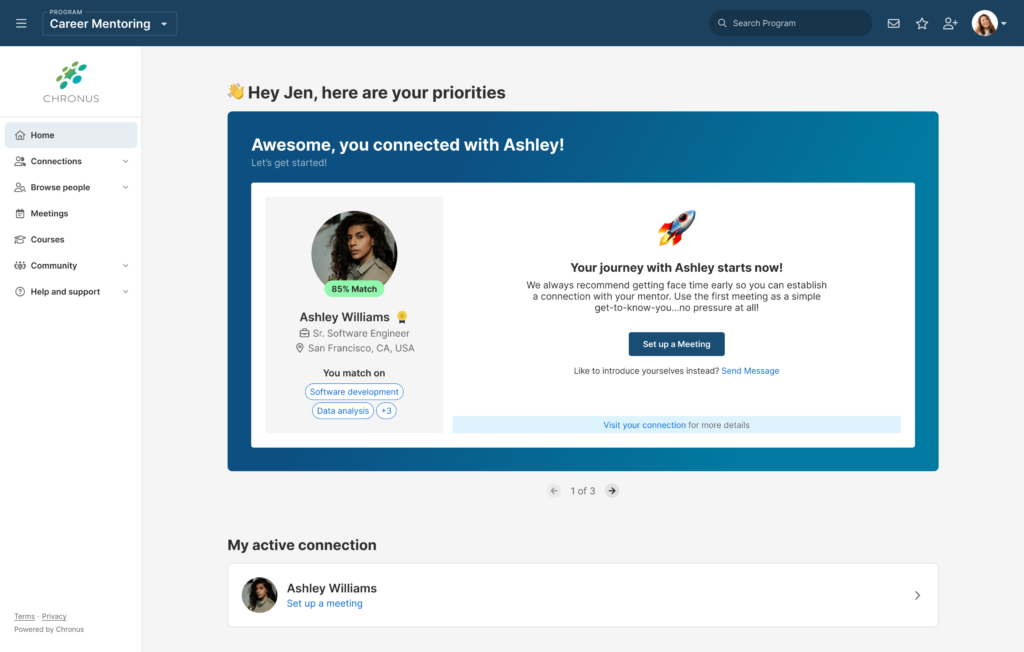Peer mentoring matches mentors and mentees with similar job titles, backgrounds, or levels of experience. These programs may match participants individually or in groups with specific goals, e.g., transfer of knowledge during onboarding.
In contrast to traditional mentoring relationships, which matches senior and junior employees to transfer knowledge and offer support, peer mentoring fosters connection between employees at roughly the same place in their career trajectory. Mentor and mentee are likely to share common challenges and goals, which enables them to relate to one another on a level that other mentorship pairs cannot.
Mentors and mentees benefit from peer mentoring. Each can gain specific technical knowledge, industry insight and career development tools. They may also develop a connection that provides deep support and assistance over the course of their career.
What is an example of a Peer Mentoring Relationship?
Caterpillar Inc. uses peer-to-peer mentoring as part of its onboarding process to boost workplace safety and inclusion. The U.S.-based construction manufacturing equipment maker introduced its Guardian Program in 2019 to pair new hires with experienced employees at their job level. Guardians answer mentees’ specific questions about daily tasks and safety protocols, but they also provide a greater sense of belonging.
Employee surveys have shown significant improvement in employee survey results, according to the company. Caterpillar facilities using the program reported positive changes in inclusion and recognition, as well as increases in professional development opportunities for participants.
Understanding Peer-to-Peer Mentoring: A Pathway to Personal and Professional Development
Peer mentoring enhances skills development by leveraging shared knowledge, experience and challenges. Participants can reinforce their own learning, ask questions in an environment of trust, and give and receive emotional support during the process.
Because peer mentors have less influence over their partner’s career path than a manager or senior leader, mentees may find it easier to seek and act on feedback. Peer mentoring relationships also model a collaborative work culture.
These programs offer support for broader diversity, equity and inclusion (DEI) initiatives, as well. For example, the International Journal of Environmental Research and Public Health evaluated data from a peer mentoring program aimed at supporting African American leaders. Their analysis showed participants benefiting from “holding behaviors” like enabling perspective and empathetic acknowledgment. Participants described their mentors as “sounding boards” and “safe havens.”
There was also evidence that the mentor pairs developed greater trust over the year-long program, enabling them to tackle sensitive issues related to work-life balance and interpersonal conflict.
Benefits of Peer Mentoring: Why It Matters in Today’s Workplace
Today’s workforce faces unique challenges related to skills development, culture and connection. Remote and hybrid work gained steam during the pandemic, creating issues and opportunities. Technology is also changing at a rapid pace, requiring employers to invest in upskilling and reskilling their workforce.
Peer to peer mentoring helps organizations meet challenges such as:
Employee Support and Connection
Remote workers in particular suffer from loneliness, according to Buffer’s State of Remote Work 2022 survey. Respondents cited loneliness as their second most significant issue, just behind not being able to unplug. Structured peer mentor programs can help create support systems for remote and hybrid workers that might not evolve on their own otherwise. Further, mentoring programs foster belonging and improve employee mental health.
Engagement and Job Satisfaction
Mentoring programs create a coaching culture, which Deloitte research has shown to be highly correlated with employee engagement and retention. These initiatives may attract new workers, as well; millennial candidates place a high value on learning opportunities, according to a Gallup report. Studies have also shown increased job satisfaction for employees who participate in mentoring programs versus those who do not.
Upskilling
Peer mentoring relationships give employees a chance to work closely with peers who have similar goals, including skills development. This is an attractive option for both employees and organizations. In one Gallup survey, 72% of employees said they were interested in upskilling. On the employer side, upskilling offers cost savings due to reduced turnover and increased profitability and productivity.
Establishing a Strong Mentoring Partnership: Key Steps for Success
Creating a successful mentoring program requires planning. Without clear goals, metrics and training, it’s impossible to say whether a program fulfills the needs of the organization.
One of the most important steps in designing any mentoring program is matching mentors and mentees. A typical process starts with setting criteria including requirements for participation and the number of employees in the program.
Then, you will decide which kind of mentor-mentee matching you’d like to use:
- Self-matching allows users to select their own mentors and mentees, providing more flexibility and reducing administrative burden.
- Admin matching matches pairs based on specific parameters.
- Bulk matching pairs mentors and mentees in batches, saving time for large mentoring programs.
- Hybrid matching combines two matching types, e.g. admin and bulk matching.
For peer mentoring, you may wish to provide some level of self-matching. However, be sure to set clear expectations and goals, as well as emphasize the importance of regular communication and feedback.
 Deciding Between Peer Mentoring and Other Mentoring Styles
Deciding Between Peer Mentoring and Other Mentoring Styles
When deciding between peer mentoring and other types of mentoring, it’s important to consider the goals of the mentoring relationship and the participants’ needs.
- Peer mentoring is ideal when both parties are at similar stages in their careers or personal development, as it fosters a collaborative, equal exchange of knowledge, skills, and support.
- Traditional mentoring is more hierarchical, where a more experienced individual guides a less experienced mentee, offering wisdom, career advice, and industry insights. This style is beneficial when the mentee seeks expert knowledge or career advancement strategies.
- Reverse mentoring flips the traditional model by having a younger or less experienced person mentor a senior individual, often in areas like technology or modern workplace trends. This approach is valuable when senior leaders need fresh perspectives or to learn new, rapidly evolving skills.
The choice between these styles should be guided by the participants’ specific goals and what type of learning and growth they want to achieve.
Nurturing Effective Communication: Building Trust and Encouraging Open Dialogue
Peer mentoring thrives or fails on the strength of the relationships that evolve during the process. To facilitate trust building and communication, be prepared to provide resources related to:
- Active listening: Resist the temptation to assume that participants are familiar with this concept. Provide examples of active listening techniques and an opportunity to practice them.
- Trust-building: Discuss the need to create a safe space that allows for open dialogue, respectful feedback and trust.
- Communication challenges: Offer examples of common communication challenges and tips for overcoming these issues.
Peer Mentoring Activities
Need help thinking through activities for you and your partner? Here’s a list of peer mentoring activities:
- Goal Setting: Help each other define short-term and long-term goals.
- Skill Sharing: Teach and learn specific skills from each other (e.g., time management, public speaking).
- Problem-Solving Discussions: Work together to solve challenges one of the peers is facing.
- Feedback Exchange: Provide constructive feedback on each other’s work or behavior.
- Role-Playing Scenarios: Practice challenging situations (e.g., job interviews, conflict resolution) through role-play.
- Progress Check-Ins: Review progress on previous goals or tasks and discuss improvements.
- Resource Sharing: Exchange helpful resources such as books, articles, or tools.
- Mind Mapping: Collaborate on brainstorming or mind mapping ideas related to personal or professional projects.
- Case Study Review: Analyze and discuss real-world case studies related to work or interests.
- Networking Advice: Share strategies for networking and building professional relationships.
- Confidence Building Exercises: Work on boosting self-confidence through affirmations or positive reinforcement.
- Mock Presentations or Pitches: Practice presentations or business pitches and receive feedback.
- Emotional Support: Discuss personal struggles and provide emotional support or coping strategies.
These activities can foster growth, support, and skill-building during peer mentoring sessions.
Get the Most Out of Your Peer Mentoring Programs
Even the best-designed peer mentoring program can fail if its participants don’t make the most out of the experience. To realize the benefits of the initiative, mentees and mentors should consider the following steps:
Mentees can:
- Take ownership of learning. Come to the process with your own wishlist of goals, e.g., learning a specific skill or gaining a specialized type of experience.
- Commit to ongoing reflection. Invest time and energy in considering your progress, listening to feedback and revising your objectives.
- Develop a growth mindset. Trust that you can improve your skills and abilities by committing to the process. There are several steps you can take in learning how to develop a growth mindset.
Mentors can:
- Prioritize regular check-ins. It’s easy to let mentoring check-ins fall by the wayside when your schedule fills up. Resist the urge to cancel or reschedule. Show commitment.
- Establish goals and KPIs. Work with program managers to set metrics and define success.
- Stay flexible. As your mentoring relationship evolves, your goals may change. Be ready to adjust as needed.
Peer mentoring programs can help upskill your workforce, improve retention and job satisfaction, and build an environment of trust. To learn more about what these initiatives can achieve, read our discussion of peer mentoring in higher education. Or, find out how Chronus’s solutions can help your organization achieve its goals.
How Chronus Mentoring Software Empowers Effective Peer Mentoring Programs
Chronus mentoring software enables peer mentor programs by providing a structured, user-friendly platform that facilitates meaningful connections between peers. With its automated mentor-mentee matching system, Chronus allows participants to find the best fit based on their skills, interests, and goals. The platform supports knowledge sharing, skill building and collaboration between peers in these mentoring connections.
The mentoring connection homepage shows a mentees’ top priorities and ongoing mentoring connection.
Its features help participants stay engaged and accountable throughout the mentoring process and include:
- goal tracking
- scheduling
- progress monitoring
- integrated communication tools
Additionally, Chronus offers analytics and reporting tools, giving program administrators insights into the program’s success and areas for improvement, ensuring an optimized peer mentoring experience for all participants.



 Deciding Between Peer Mentoring and Other Mentoring Styles
Deciding Between Peer Mentoring and Other Mentoring Styles